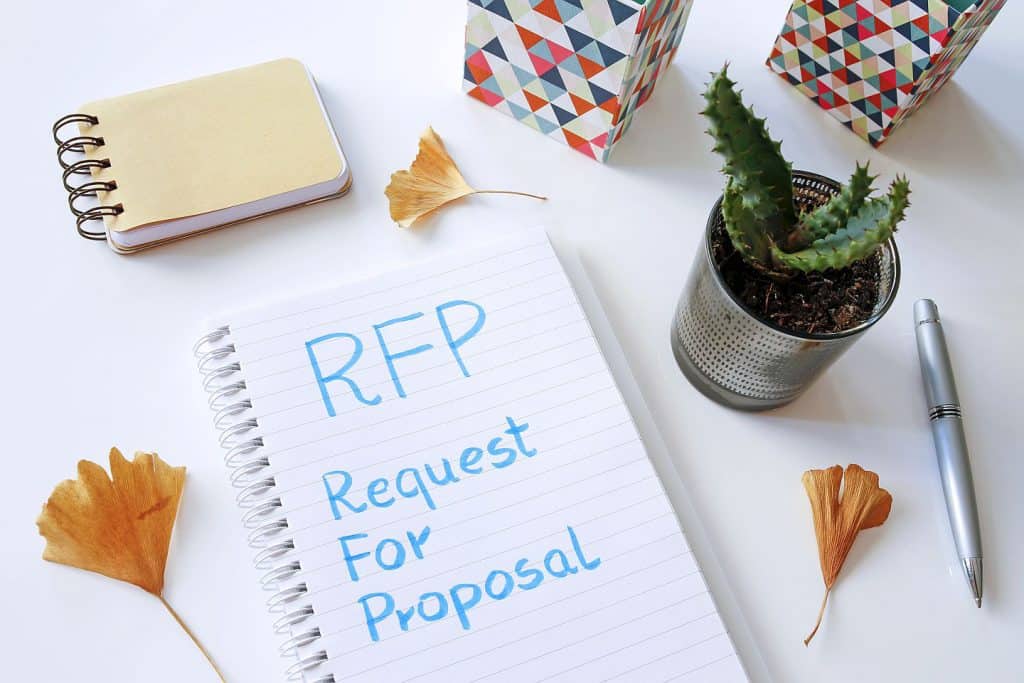A request for proposal (RFP) is a document that solicits information from potential vendors or contractors in order to estimate the cost of completing a project or providing goods or services. The RFP will typically include an overview of the scope of the project, along with any requirements and criteria that the vendor should consider when responding to the RFP.

Request for Proposal: What it is and how to use it
When it comes to making big decisions for a business, often the best way forward is to ask for help from professionals. That’s where a request for proposal, or RFP, comes in. In this blog post, we’ll cover what RFPs are and how they work, as well as provide an overview of related terms and outline who is involved in the process and when to use an RFP.
What does RFP stand for?
RFP stands for “request for proposal”. An RFP is a document that outlines the details of a project or service an organization needs help with and invites potential vendors to submit proposals outlining how they can address these needs.
Proposal meaning
A proposal is a response to an RFP written by a vendor. It should include details about the company and how they intend to approach the project or fulfill the services outlined in the RFP. It should also clearly state pricing information so all vendors can be compared on equal footing.
Terms related to Request for Proposal
In addition to understanding what a request for proposal (RFP) is, there are several other related terms you will encounter, including:
- RFX: RFX is an abbreviation that refers to any of the various “request-for [something]” documents, such as requests for information (RFI), requests for quotation (RFQ), and requests for proposals (RFPs). RFX documents are used by organizations in order to obtain specific information from potential vendors.
- Request for Information (RFI): An RFI is a type of RFX document that organizations use to request additional information about potential vendors and services. The main purpose of an RFI is to gather facts, research, cost estimates, pricing models, and other details related to the project or service in question. It usually precedes an RFP or RFQ.
- Request For Quotation (RFQ): An RFQ is a solicitation focused on the economic aspects (pricing and payment terms) of a well-defined purchase. Buyers will typically use an RFQ when they know exactly what they are buying and are basing their evaluation exclusively on price.
- Bid: A bid indicates acceptance of an invitation and provides pricing information in response to both an RFP or RFQ.
- Solicitation: This term refers broadly referring to any communication regarding a vendor working on behalf of an organization requesting bids such as those sent out by government agencies seeking contractors for projects like construction work or software development services.
How do RFPs work? A guide to the Request for Proposal process
There are typically 4 steps to the RFP process:
- Discovery
- Draft and Issue
- Score and Shortlist
- Selection

Let’s examine each of these steps in more detail:
Discovery
This is the process of gathering data from stakeholders and identifying which goals, objectives, requirements, and criteria will be included in the RFP.
Draft and Issue the Request for Proposal
Once the requirements have been established, it’s time to create the actual RFP document. The document should include an overview of the project or service work needed as well as detailed instructions on how vendors should respond. It should also include the timeline for responding to the RFP, as well as any other documents that need to be submitted.
Score and Shortlist
Once proposals have been submitted, the organization will evaluate each one based on criteria outlined in the RFP. This may include technical and financial considerations as well as other factors such as customer service or delivery time.
Selection
Finally, the organization will select a vendor for the project or service and award a contract. This selection is usually based on each vendor’s ability to satisfy the criteria outlined in the RFP as well as their price point.
(Note that this is a very short overview – to learn more about running an effective RFP process check out our other resources.)
Who participates in an RFP process?
The RFP process involves both buyers and vendors. Each side will typically have multiple participants involved in the process.
Buyer RFP Participants
The buyer’s RFP participants typically include:
- The person or team responsible for drafting and/or approving the RFP
- The project manager who is overseeing the post-bid implementation/integration
- End-user representatives (if applicable)
- Financial personnel responsible for evaluating bids
- Executive sponsor
Vendor RFP Participants
The vendor’s RFP stakeholders typically include:
- Sales personnel responsible for responding to the RFP
- Technical personnel or subject matter experts who can provide detailed information about the service or product being requested
- Financial personnel who will submit pricing details and payment terms
When to use a Request for Proposal (RFP)
The RFP process should be used whenever the purchase is complex, large, or both. It’s a great way to make sure that the best possible vendor is selected for the project or service in question. The process also helps ensure transparency and fairness, which can help build trust among stakeholders, both inside and outside the organization.
By using an RFP, organizations can save time and resources in their procurement process. In addition, the standardized format helps ensure that all prospective vendors are familiar with how to submit a bid and what criteria will be used in the evaluation process. This can make it easier for buyers to compare bids and select the best vendor for the job.
It’s important to note that the RFP process is not the only way to select a vendor. Other methods such as direct negotiations or reverse auctions may be more appropriate depending on the circumstances.
It’s also important to use the right tool for the job! If you’re early in your project, an RFI might be the most appropriate tool to use. And if you’re going to make a decision entirely or almost entirely based on price, you can save yourself and your vendors a great deal of time by issuing an RFQ instead of an RFP. And formal bids are just a subset of the tools available to a procurement professional!
Ultimately, it’s up to the organization to decide which approach best suits their needs. By understanding how RFPs work, however, organizations can make an informed decision about how to best procure goods and services.
